Your Guide to English Garden Architecture and Landscape Design

Homes with timeless charm and unique character have a way of standing out. However, their outdoor spaces don’t always reflect the same elegance.
Overgrown plants, old walkways, or clashing designs can take away from your home’s magic, making the yard seem out of sync with the house’s historic essence.
Many homeowners in Toronto want to improve their interiors. This often leads to the next step of updating the outside curb appeal too. They want to create a nice outdoor living space as well. Luxury English cottage garden landscaping offers a great way to combine classic designs with beautiful plants. It improves your home’s look and respects its history.
Explore how English garden architecture and landscape design can turn your yard into a seamless extension of your living space, marrying elegance with functionality.
What Defines an English Garden?

English gardens are celebrated for their timeless appeal. They are a perfect blend of structure, elegance, and natural beauty. This iconic cottage-style design transforms outdoor spaces into serene, living works of art, making it a popular choice for century home landscaping ideas. Unlike formal French gardens or minimalist Japanese Zen gardens, English gardens balance human intention with the untamed charm of nature, creating a space that feels inviting, enchanting, and alive.
Imagine stepping into your garden and feeling like you’ve entered a tranquil masterpiece. Every detail, from the lush greenery to the carefully placed stone pathways, has a purpose—this is the beauty of an English garden.
The Philosophy of an English Garden
English gardens are designed to look effortless, but their beauty lies in their deliberate craftsmanship. Unlike gardens that prioritize strict geometry or minimalist simplicity, this traditional garden landscaping embraces abundance and flow. Winding paths, layered planting, and thoughtfully placed features create a space that feels organic yet intentional.
The essence of this philosophy lies in the interplay between control and wildness. Neatly clipped hedges define the garden’s structure, while climbers like roses and wisteria soften the edges. This balance ensures that every corner of the garden invites exploration and connection.
Imagine stepping into your garden and feeling like you’ve entered a tranquil masterpiece. Every detail, from the lush greenery to the carefully placed stone pathways, has a purpose—this is the beauty of an English garden.
Key Features That Define English Gardens
Symmetry Without Rigidity
English gardens often feature elements of symmetry, but it’s used sparingly to avoid feeling overly formal. Pathways and planting beds are arranged with balance in mind, creating a sense of harmony rather than strict order.
Design Tip: Use natural curves in pathways to guide the eye and invite visitors to explore. Consider framing symmetrical features, like a stone fountain or central flower bed, with softer, asymmetrical plantings to keep the look approachable.
Layered Planting: Depth and Texture
Layering is at the heart of English garden design. Groundcovers like moss and thyme soften pathways, while mid-level plants such as hydrangeas and boxwood hedges provide structure. Taller elements, like climbing roses and flowering trees, create a canopy of colour and height.
Pro Tip: Mix evergreen shrubs with seasonal perennials to ensure your garden offers visual interest throughout the year. This layering technique also helps create depth, making smaller spaces feel expansive.
The Importance of Colour Harmony
Colour plays a vital role in setting the tone of an English garden. Subtle palettes of soft pinks, purples, and whites dominate, with occasional bursts of brighter hues to add drama. These colours are often repeated throughout the garden to create a cohesive, calming atmosphere.
Quick Inspiration: Group flowers in clusters of complementary colours, like lavender and pale yellow, to achieve a natural yet intentional look. Avoid overly contrasting tones to maintain the garden’s serene feel.
The Role of Water Features
From reflective pools to small stone fountains, these features add a sensory element that enhances the garden’s tranquillity and acts as a calming presence. The gentle sound of running water masks urban noise, making your outdoor space feel like a true escape.
Placement Idea: Position water features near seating areas to maximize their soothing effect. A reflective pool surrounded by tall hedges creates a peaceful oasis, while a bubbling fountain can serve as a focal point for the garden.
English Gardens vs. Other Styles
While English gardens are timeless, their differences from other popular styles highlight their unique appeal.
How English Gardens Compare to French Formal Gardens
French gardens emphasize strict geometry and grandeur, often featuring ornate parterres and long, straight pathways. English gardens, by contrast, focus on intimacy and natural flow.
- Visual Focus: French gardens are designed to impress from a distance, while English gardens invite closer inspection and interaction.
- Philosophy: French gardens prioritize control and symmetry, while English gardens balance order with the organic beauty of nature.
Seasonal Beauty for An Ever-Changing Landscape
English gardens are designed to thrive through every season, ensuring they’re never static.
- Spring: Tulips, daffodils, and flowering trees bring fresh vibrancy.
- Summer: Roses, hydrangeas, and lavender dominate, creating lush textures and rich fragrances.
- Autumn: Fiery hues of Japanese maples and asters offer warmth and depth.
- Winter: Evergreen hedges, holly, and snow-dusted trees maintain the garden’s structure.
Planting Tip: Choose plants with staggered bloom times to create a garden that evolves throughout the year. Pair winter evergreens with spring bulbs to ensure there’s always something to admire.
Architectural Elements in English Gardens
English gardens are not just about plants—they also incorporate architectural features to add character and structure.
- Trellises and Arbors: Covered in climbing roses or ivy, these vertical elements create gateways and focal points.
- Wrought Iron Gates: Add an element of mystery and charm, leading to hidden areas or “garden rooms.”
- Stone Walls and Pathways: Often made from reclaimed materials, these features enhance the garden’s timeless aesthetic.
Historical Insight: Ha-ha walls, a feature unique to traditional English gardens, were used to maintain uninterrupted views of the landscape while keeping grazing animals out.
The Emotional Appeal of English Gardens
English gardens resonate on an emotional level, creating spaces that feel deeply personal and restorative. Unlike formal or minimalist designs, they invite you to engage with the space fully—to touch the leaves, smell the blooms, and listen to the water. Every element, from the meandering paths to the layered plantings, is designed to make you feel connected to nature and to the garden itself.
This emotional connection is what makes English gardens such a perfect fit for Toronto’s century homes. They complement the historic charm of these properties while creating a space where the past and the present can coexist harmoniously.
Modern Touches in Traditional Gardens
Can a garden be both classic and contemporary? With thoughtful updates, your English garden can honour tradition while embracing today’s comforts.
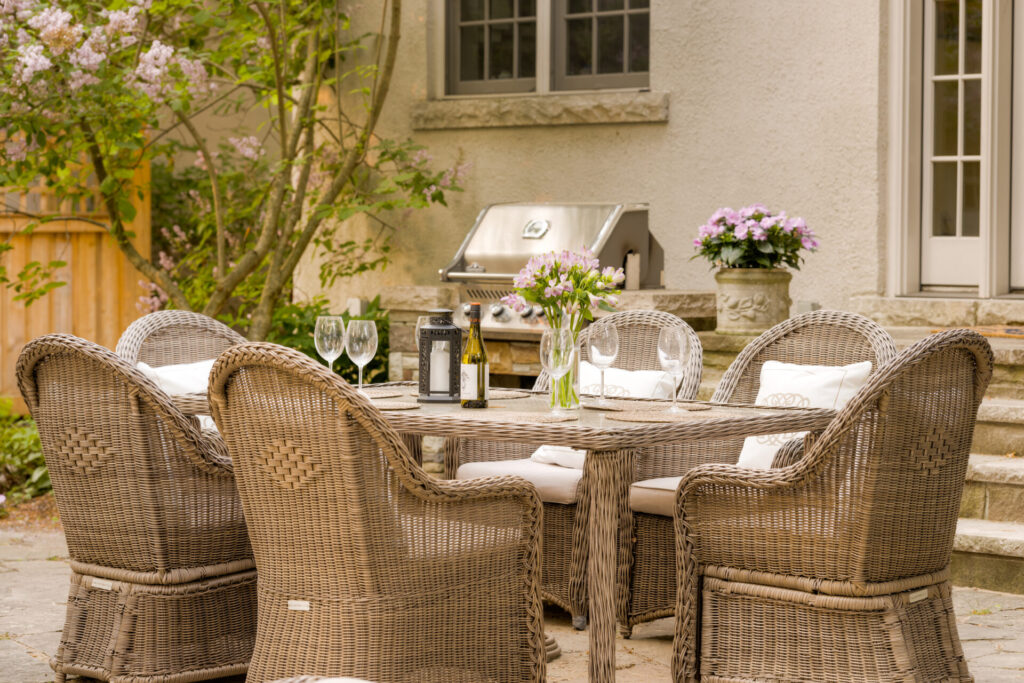
While English gardens are rooted in tradition, incorporating modern elements can enhance their usability and relevance for today’s lifestyles. By blending classic design with contemporary updates, you can create a garden that feels timeless and practical.
Old Meets New
Imagine sleek outdoor furniture nestled against a backdrop of antique stone walls. A cobblestone pathway leads to a minimalist water feature. These modern touches add functionality and contrast without compromising the garden’s traditional charm.
Modern Enhancements to Explore:
- Eco-Friendly Lighting: Low-voltage outdoor LED lights can illuminate pathways and highlight key features.
- Sustainable Design: Use reclaimed stone for walkways or integrate rainwater collection systems.
- Multi-Functional Spaces: Combine formal garden beds with contemporary patios or decks designed for entertaining.
Striking the Right Balance
Modern updates should feel like a natural extension of the garden’s design, not an interruption. Choose neutral tones, simple lines, and materials that complement the organic elements of your outdoor space.
Pro Insight: Modern additions don’t replace tradition; they refine it. The goal is to highlight the timeless beauty of an English garden while making it more accessible and functional.
The Importance of Stonework in Garden Design

Stonework is the foundation of any great garden—it grounds the space, adds texture, and creates flow. It is an indispensable element in luxury English garden design. From elegant pathways to sturdy retaining walls, it provides structure and a sense of permanence. In Toronto’s century homes, incorporating high-quality masonry landscaping ideas honours the property’s history while elevating its aesthetic.
Why Stonework Matters:
- Pathways: Stone paths guide the journey through your garden, connecting different areas while adding visual appeal.
- Retaining Walls: These functional features frame planting beds and define levels, making your garden appear more dynamic.
- Focal Points: A stone bench or sculpture can serve as an anchor, drawing attention and adding character.
Expert Tip: Match your garden’s stonework to your home’s existing masonry to create a cohesive look. Consider materials like flagstone or limestone, which weather beautifully over time.
The Role of Garden Pathways in English Garden Design
Pathways guide not only your footsteps but also your experience of the garden.
Pathways are an essential element of English garden design. They define movement, create visual intrigue, and connect the various elements of your garden.
Materials to Consider
- Gravel: A cost-effective option that adds texture.
- Brick: Adds warmth and character, perfect for century homes.
- Flagstone: Durable and elegant, ideal for formal pathways.
Layout Ideas
Use meandering paths to invite exploration or straight, symmetrical designs for a formal feel. Incorporate planting borders to soften the edges and enhance the pathway’s visual appeal.
The Timeless Appeal of Stone
Unlike other materials, stone improves with age, becoming an integral part of the garden’s story. Its durability ensures your garden remains stunning for years, adding both form and function to the design.
Choosing Plants for Your English Garden
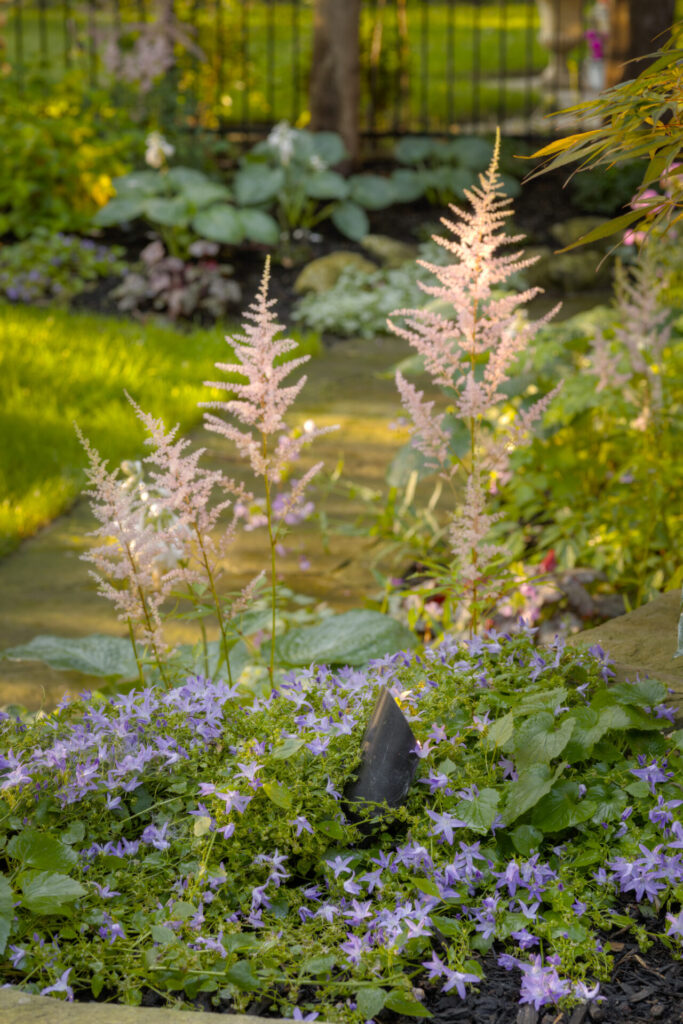
Plants are the heart of your garden, each contributing its unique texture, colour, and fragrance to create a living masterpiece.
The right plants can elevate your English garden, adding layers of interest and enhancing its connection to your home. With intentional planning, you can create a garden that thrives through every season.
Iconic Plants for an English Garden
- Roses: Perfect for climbing over arches or trellises, adding romance and charm.
- Boxwood Hedges: Provide structure and symmetry, essential for creating formal lines.
- Perennials: Delphiniums, foxgloves, and lavender bring seasonal bursts of colour.
- Groundcovers: Creeping thyme or moss softens pathways and adds texture.
Pro Tip: Layer plants by height and bloom time to create depth and ensure continual interest.
Seasonal Planting Plan
Spring: Peonies, tulips, and early-blooming perennials.
Summer: Roses, hydrangeas, and fragrant lavender.
Autumn: Japanese maples and ornamental grasses.
Winter: Evergreens and holly for structure and colour.
Adapting to Toronto’s Climate
Incorporate hardy native plants alongside traditional English varieties to ensure your garden thrives in Toronto’s seasonal extremes. Heat-resistant perennials and cold-hardy shrubs can enhance both sustainability and resilience.
Insight: A well-curated plant selection ensures your garden maintains its lush, vibrant appeal year-round while reducing maintenance demands.
Creating Spaces for Pollinators and Birds in Your English Garden
English gardens aren’t just for people—they’re a haven for pollinators like bees and butterflies, as well as birds that support the natural ecosystem. By making intentional choices with these simple backyard landscaping ideas, you can create a biodiverse space that supports nature while adding movement and life to your garden.
Ways to Invite Wildlife
- Pollinator Plants: Include lavender, echinacea, and wildflowers to attract bees and butterflies.
- Bird-Friendly Features: Add birdbaths, feeders, and berry-producing plants.
- Water Sources: Small ponds or fountains provide drinking spots for various animals.
A garden alive with birdsong and buzzing bees is one that truly feels complete.
Maximizing Small Spaces with English Gardens

Even the smallest garden can exude the charm and elegance of an English garden with thoughtful design.
For homeowners with limited outdoor space, an English garden design can still shine. By focusing on essential features and creative layouts, small gardens can be transformed into stunning, intimate retreats.
Tips for Small Gardens
- Vertical Gardens: Use trellises or wall-mounted planters to add greenery without taking up valuable ground space.
- Compact Features: Choose smaller versions of classic elements like mini fountains or trimmed hedges.
- Multipurpose Areas: Combine seating with hidden storage for functionality.
- Layered Design: Use tiered planting beds to add depth and dimension.
- Opt for Containers: Create movable bursts of greenery and colour.
Case Study: Front Yard Elegance
A Toronto client transformed their small front yard by incorporating a simple stone retaining wall and pillar, perennial garden bed, ornamental tree, and new staircase. Despite its size, the space feels lush.
When working with limited space, intentionality is key. A small English garden can make a big impact.
With careful planning, even a balcony or courtyard can become a luxury, sophisticated space.
Elevating Your Garden with Art and Sculpture

Art transforms a garden from a beautiful space into a captivating story.
Art brings a unique personality to any garden, creating a place of wonder and reflection. Whether subtle or bold, sculptures and other art pieces become integral to the garden’s narrative, offering visitors moments of surprise and connection.
Art Beyond Decoration
Sculptures and installations are not just decorative; they shape the experience of the garden. Interactive elements, like sundials or wind-driven kinetic sculptures, engage the senses, creating a deeper connection to the space. These pieces become focal points, encouraging exploration and adding layers of meaning.
Incorporating seasonal elements can also elevate your garden’s charm. For example, a terracotta urn spilling over with summer petunias can be replaced in winter with an arrangement of evergreen branches and twinkling fairy lights. This rotating display ensures your garden remains dynamic and fresh year-round.
Tips for Placement
Well-placed art turns the ordinary into the extraordinary. Hidden pieces, like a small bronze statue nestled in a bed of lavender, invite discovery. Meanwhile, dramatic sculptures can frame entrances or provide structure to open spaces. Pedestals and plinths offer an opportunity to elevate smaller pieces, ensuring they aren’t lost amidst greenery.
Top Tip: Collaborate with local artists to commission site-specific installations. These custom pieces enhance the aesthetic and add a personal story to your garden.
Lighting as the Finishing Touch
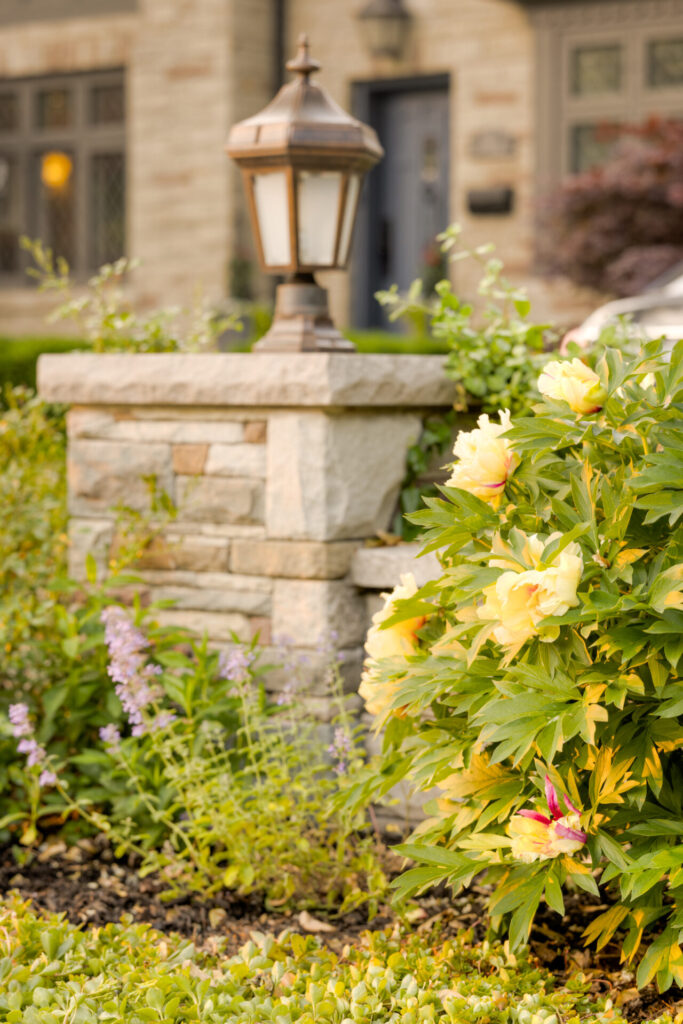
Lighting does more than brighten your garden, it sets the mood and highlights its best features.
When the sun sets, well-placed lighting transforms your garden into a magical retreat. Lighting highlights key features while creating an inviting atmosphere, allowing you to enjoy your garden long after dusk.
Bright Ideas for Illumination
Ambient lighting plays a pivotal role in defining a garden’s mood. Soft string lights draped across pergolas or tucked into hedges create a warm glow, perfect for evening gatherings. For pathways, low-level lights guide visitors safely while casting enchanting shadows. Accent lighting, meanwhile, draws attention to standout features, such as a flowering tree or a cascading fountain.
Subtle colour accents can enhance your garden’s ambiance. Use cool-toned lights to emphasize silvery foliage like lamb’s ear or warm lights to highlight vibrant roses. Combining different tones and intensities creates visual interest, making your garden feel layered and alive.
Layering Light for Depth
Thoughtful layering of light enhances depth and dimension. Start with general ambient lighting to provide overall visibility. Then add task lighting for functional areas like outdoor kitchens or patios. Finally, use accent lighting to highlight specific plants, sculptures, or architectural elements.
Quick Tip: Choose dimmable LEDs for versatility, allowing you to adjust the intensity depending on the occasion.
Incorporating Water Elements for Tranquility
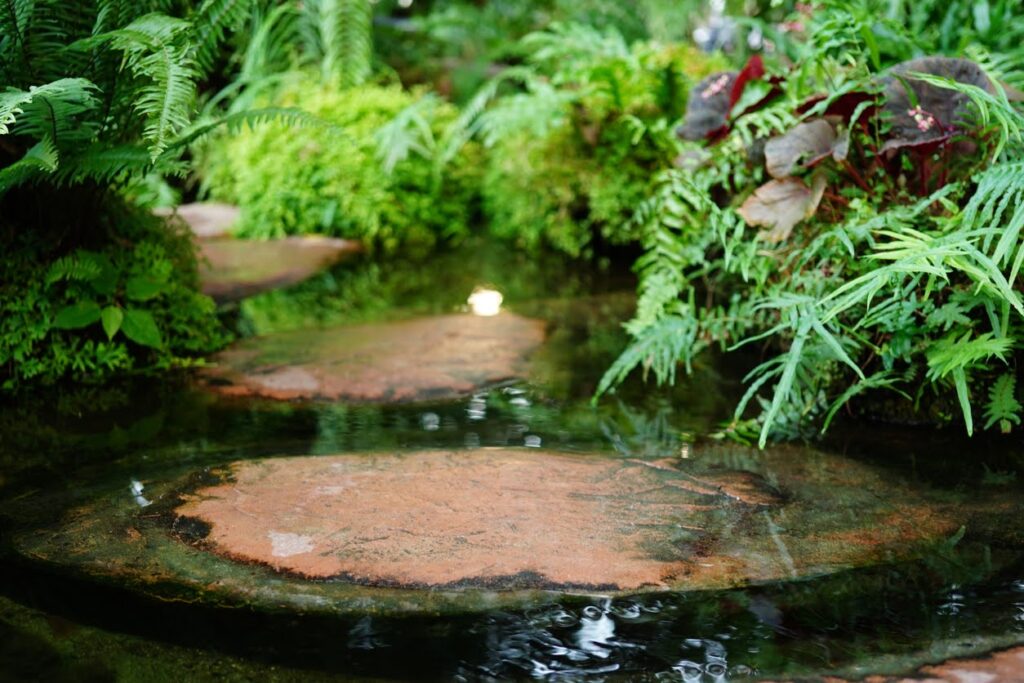
Water soothes the soul, turning a peaceful garden into a meditative escape. Its presence in a garden can transform the space, making it more dynamic and serene.
Water Features to Consider
- Cascading Walls: These sleek, vertical features combine modern aesthetics with soothing sounds, creating an oasis-like feel.
- Stepping Stone Streams: Perfect for larger spaces, these streams meander through the garden, inviting visitors to interact with the water by crossing over flat, strategically placed stones.
- Reflecting Ponds: These shallow pools double the beauty of their surroundings, offering tranquil mirrors of nearby flowers, trees, or art installations.
Positioning is crucial when designing water features. Place them near seating areas to maximize their calming effect or near paths to catch the light at different times of the day. Aquatic plants, such as water lilies or papyrus, can add colour and texture while supporting local wildlife.
Maintenance Made Simple
Keeping water elements clean and functional is key to maintaining their beauty. Install efficient filtration systems to prevent algae buildup and use self-contained features for low-maintenance solutions. If adding wildlife-friendly ponds, ensure there are gradual slopes or escape routes for small animals.
Design Tip: Enhance water features with integrated lighting to create shimmering reflections and extend their appeal into the night.
Designing for Outdoor Entertaining
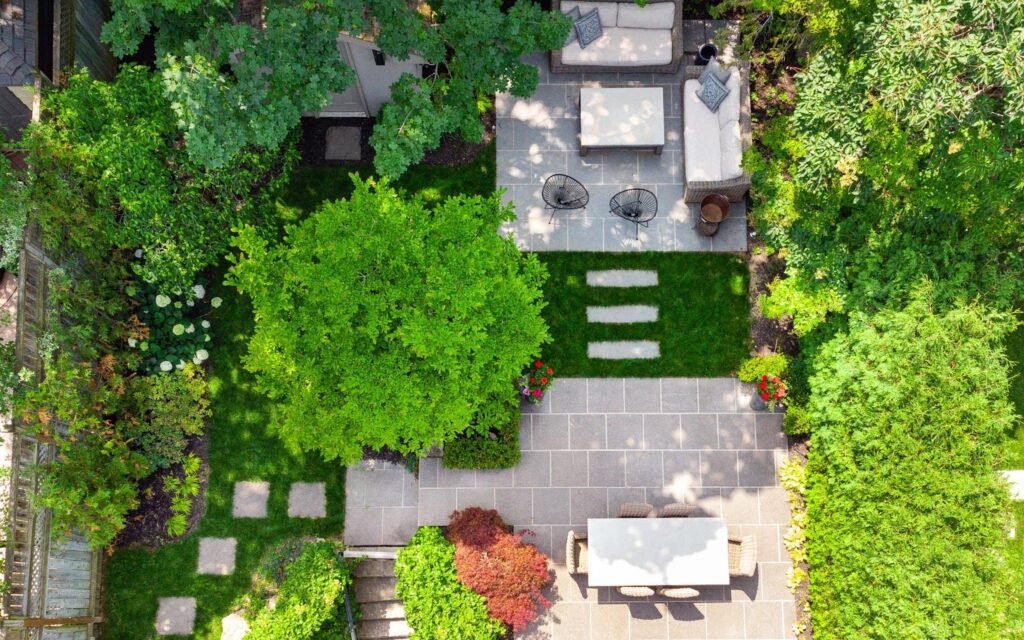
Your garden can be the perfect backdrop for unforgettable gatherings.
English gardens are not just about visual beauty; they can also be designed to host and entertain guests. Thoughtful layouts and features can transform your garden into a welcoming space for celebrations and quiet evenings alike.
Ideas for Entertaining Spaces
- Outdoor Kitchens: Include built-in grills, prep stations, and even small refrigerators for a functional cooking area.
- Seating Nooks: Strategically place benches or lounge chairs under arbours or near water features for relaxing spots.
- Ambient Lighting: Use soft string lights, lanterns, or embedded path lighting to create a cozy evening ambiance.
Event-Ready Features
Consider features like a pergola or gazebo to provide shade and shelter. These structures add elegance while ensuring comfort for your guests.
Creating Outdoor Rooms in Your Garden
An outdoor room turns your garden into a series of experiences, each with its own purpose and charm.
Outdoor rooms are defined areas within a garden that serve specific functions, such as dining, relaxing, or gardening.
How to Create Outdoor Rooms
- Define Spaces: Use hedges, trellises, or pathways to visually separate areas.
- Add Furnishings: Incorporate seating, tables, or garden benches tailored to each room’s purpose.
- Consider Lighting: Soft lighting can enhance ambiance and usability after sunset.
Outdoor rooms provide variety and functionality, making your garden a more versatile and enjoyable space.
The Role of Fencing and Boundaries in English Gardens
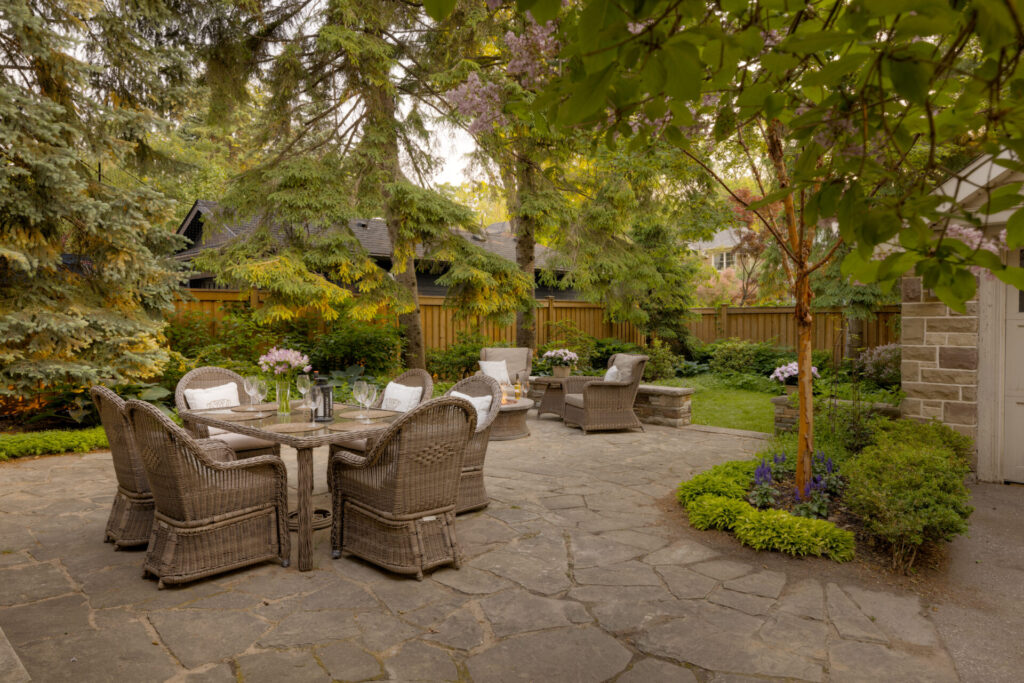
Fencing and boundaries are essential to English garden design. They provide privacy, structure, and a backdrop against which the garden’s features can shine.
Types of Fencing for English Gardens
- Traditional Wooden Fences: Add rustic charm and blend naturally with the greenery.
- Stone Walls: Durable and timeless, perfect for century homes.
- Wrought Iron Gates: Elegant and inviting, offering a peek into the garden’s beauty.
Enhancing Boundaries
Consider planting climbing roses or ivy along fences to soften their appearance and integrate them seamlessly into the garden’s design.
Boundaries define a space and frame it, creating a sense of enclosure and tranquillity.
Preserving the Legacy of Your Century Home
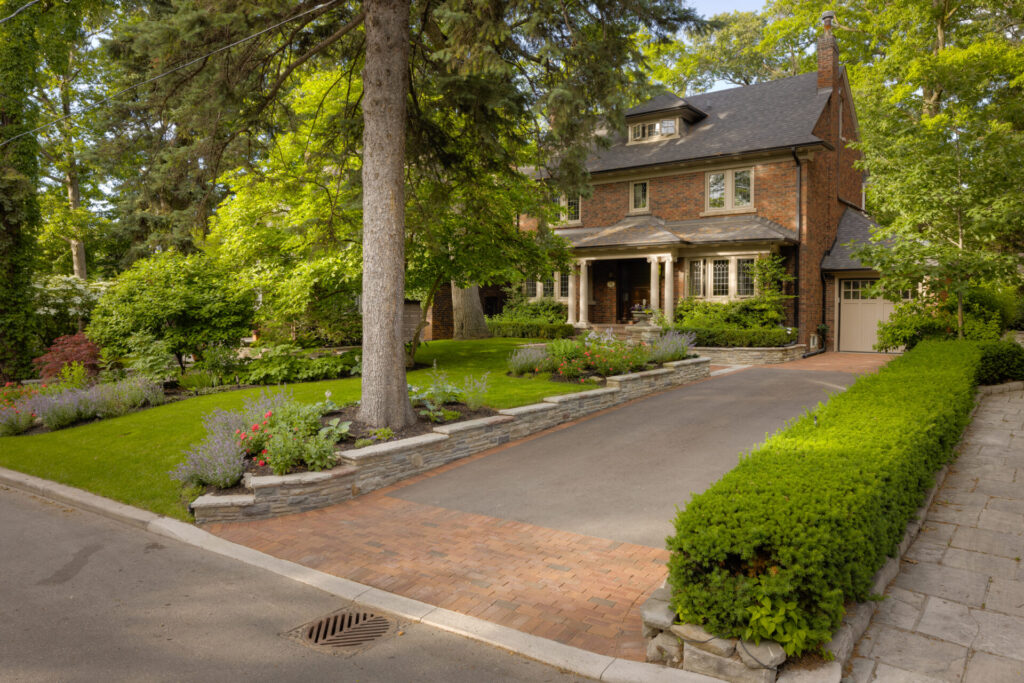
Century homes have a timeless beauty, and their gardens should amplify this legacy. By incorporating design elements that reflect the property’s historical era, you can create a harmonious connection between the home and the landscape.
How to Blend Legacy and Design
Restoring rather than replacing is often the best way to preserve a home’s historical character. Original stone walls, gates, or mature trees are irreplaceable assets that add authenticity and charm. Gentle cleaning and professional restoration can revitalize these features without losing their historic integrity.
Era-appropriate materials and plants are essential for maintaining historical accuracy. For example, Victorian gardens often featured ornate trellises, wrought iron fencing, and symmetrical layouts. Integrating these elements ensures the garden remains true to the home’s period.
Balancing History and Modern Needs
While honouring the past, gardens can still embrace contemporary conveniences. Subtle additions, such as automatic irrigation systems or low-maintenance planting schemes, can make historic gardens more accessible for modern homeowners without compromising their character.
Quick Idea: Create a timeline-inspired design by incorporating plants or features that represent different periods of the home’s history. For instance, add heirloom roses alongside more contemporary landscaping techniques.
Why a Master Plan is Essential for Your Garden’s Success

Dreaming of luxury garden design ideas without a plan is like a home without a blueprint.
Designing an English garden requires expertise, creativity, and meticulous planning. A professional landscape designer bridges the gap between your vision and the final result.
A master plan is the cornerstone of successful garden design. It ensures that every element, from lush greenery to elegant stone pathways, works in harmony to achieve your desired outcome. Thoughtful planning ensures not only beauty but also functionality, preserving your garden’s timeless appeal for years to come.
The key benefits of a master landscape design plan include:
- Clarity: A master plan outlines every aspect of the design, providing a clear picture of the final result.
- Staying on track: Helps maintain focus during construction, eliminating guesswork.
- Cost efficiency: Prevents costly revisions by having a detailed plan.
- Budget management: Allocates resources wisely to avoid unexpected expenses.
- Cohesion: Ensures every feature, like water features or sculpted hedges, complements the overall design for a unified and elegant space.
Beyond aesthetics, practical considerations are integral to a successful garden. A professional master plan considers factors such as drainage, sunlight patterns, and seasonal changes. For instance, proper planning can ensure that your plants thrive in Toronto’s climate, while pathways are positioned for both beauty and functionality. These details may seem minor, but they make all the difference in creating a seamless and thoughtfully designed garden.
How You’ll Benefit from Working with Lincoln Woods Landscapes | High-End Landscaping Toronto
Tailored Solutions: Designers take into account unique challenges, such as uneven terrain, drainage, and climate, to craft a personalized plan.
Expert Coordination: Professionals ensure all elements align seamlessly, from selecting heirloom plants to integrating modern lighting.
Time and Cost Efficiency: Avoid costly mistakes and delays with an experienced designer managing every detail.
Ready to create a timeless garden that reflects your vision?
Contact us for a consultation and take the first step toward transforming your outdoor space. Let’s start designing a garden that tells your story, preserves history, and creates a space for generations to enjoy.
